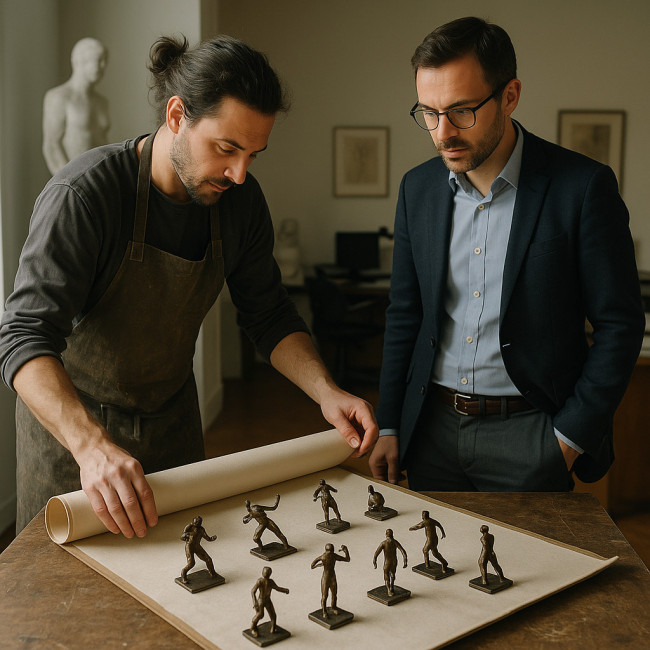Sculptor portfolio audits with curators: questions to ask before accepting briefs
Before you sign the next commission contract, run a sculptor portfolio audit with the curator who will drive the project. The right questions reveal hidden expectations, budget realities and exhibition constraints—saving you costly revisions later. This guide equips you with actionable prompts, red-flag clues and negotiation tips so you can accept only the briefs that match your creative and financial goals.
Why portfolio audits matter before you say “yes”

Visualise the scene: you and the curator sit on opposite sides of a broad drafting table; between you lie maquettes, material swatches, and budget spreadsheets. The atmosphere oscillates between creative excitement and professional scrutiny. This is not merely paperwork—this is the moment when thematic fit, audience impact, structural feasibility and financial viability fuse into a green-lit opportunity or an informed refusal. When you master this pivotal dialogue, you protect your creative vision, secure realistic timelines, and anchor your earnings to tangible deliverables rather than vague hopes. A well-conducted audit also deters post-agreement disputes because every parameter—from pedestal height to photographic licensing—is mapped, priced and acknowledged before the first cut of clay or pour of bronze.
Curators shortlist sculptors based on aesthetics and perceived reliability. A pre-brief audit allows you to:
- Validate fit: Check whether your style narrative aligns with the curator's exhibition story.
- Avoid scope creep: Clarify edition size, mounting method and conservation requirements early.
- Strengthen trust: Demonstrate professional due diligence, which can justify higher fees.
Core question clusters for a bullet-proof sculptor portfolio audit
1. Exhibition narrative & audience engagement
Ask how your pieces complement the overall curatorial thesis. Probe demographic data, visitor flow and interactive expectations. This prevents last-minute add-ons such as AR layers—yet you stay prepared to leverage digital mock-ups if the venue demands them.
2. Conservation, material and sustainability standards
Know the environmental conditions and long-term care plan. If the venue favours low-carbon materials, reference your sourcing options from eco-minded suppliers. Confirm who pays for specialised treatments and periodic patina touch-ups.
3. Fabrication & logistics partners
Curators sometimes impose preferred foundries or freight carriers. Verify whether you may choose your own bronze casters—this links directly to cost accuracy. Review insurance limits and compare them with best-practice safeguards detailed in our shipping insurance roadmap.
4. Budget staging and payment milestones
Map your cash flow against curator payout schedules. If grants co-finance the show, request the filing calendar. You can then align milestones with the template in our grant-budget guide.
5. Marketing & licensing rights
Clarify how images, 3D scans or VR walkthroughs will be used. Insert clauses that secure royalties for additional print runs or digital merchandise. A simple mention of scope clauses in conversation signals your professionalism.
Comparative table: questions, insights, and next steps
| Question category | Key insight you gain | Recommended action |
|---|---|---|
| Story alignment | Theme consistency, curatorial tone | Prepare tailored artist statement |
| Material standards | Humidity, load limits, eco labels | List alternative alloys or resins |
| Logistics control | Approved vendors, insurance caps | Negotiate freight choice & risk split |
| Budget rhythm | Cash-flow timing, grant windows | Sync milestone invoices |
| Licensing reach | Media formats, future editions | Draft royalty ladder |
Sculptor portfolio audits with curators: pro tips
- Share context-rich visuals: Annotated mock-ups outperform bare JPEGs.
- Quantify precedents: Cite past installs, visitor numbers, and press hits to justify scale.
- Leverage public benchmarks: Platforms such as Artfolio's collaboration board reveal going rates and deliverable norms.
- Document every answer: Convert verbal confirmations into an addendum within 24 hours.
Micro-quiz: test your audit readiness
FAQ
- How long should a sculptor portfolio audit with a curator take?
- Plan one 60-minute video call for initial questions plus a 15-minute follow-up after you share tailored mock-ups.
- Do I need a different portfolio version for every curator?
- Not entirely. Keep a modular slide deck where you swap hero images and process notes to match each exhibition theme.
- What if the curator's budget is lower than my material cost?
- Present scaled-down options or suggest alternative alloys. If gaps persist, politely decline—your margins matter.
- Who pays for shipping damage if the insurer rejects a claim?
- Clarify liability splits in contract language. Many sculptors add a contingency fee to cover uninsured risks.
- Can I post work-in-progress shots on social media during fabrication?
- Only after you secure written consent from the curator; some institutions embargo all visuals until opening night.
Next step: turn insights into secured, high-value briefs
Now that you know how to lead sculptor portfolio audits with curators, integrate these questions into your discovery workflow. Clients will recognise your foresight and reward you with clearer scopes, fairer budgets and smoother installations.
Ready to upgrade your commission pipeline? Create a reusable audit checklist today and watch your approval rate climb.











